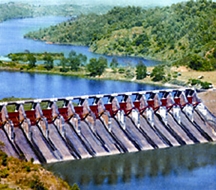Karnafuli Hydropower Station
Karnafuli Hydropower Station the only hydropower plant in the country is located at kaptai, about 50 km from the port city of chittagong. This plant was constructed in 1962 as part of the 'Karnafuli Multipurpose Project', and is one of the biggest water resources development project of Bangladesh.
After being commissioned in 1962, the plant could feed the national grid with 80 MW of electricity. In later years, the generation capacity was increased in two phases to a total of 230 MW. The plant not only plays an important role in meeting the power demand of the country but is also vital as a flood management installation for the areas downstream.
The earth-filled dam Kaptai is an earth-filled dam. It is 45.7m (36m MSL or mean sea level) high and 670.6m long. The maximum width is 7.6m and width at the foot is 45.7m. The 16-gated spillways, each 12.2m by 11.3m, can together pass a flow of 625,000 cusec.
The average annual flow in the reservoir is approximately 15,646 MCM. The flood absorption capacity is 8.25 million Ac-ft and the flooded area at 33m MSL is 777 sq km.
After several surveys, the Kaptai site was selected in early-1952 for building the dam. In fact, Kaptai is an arc-shaped canal between the river Rinkhyong at the upstream and the fountain Freengkhyang at the downstream. As per design, the dam at the uphill end of the arc would stop the waterflow and the water thus arrested would create a large reservoir, but when released through the tunnel-like route, would activate machines for generating electricity. With this plan the then government of Pakistan approached USA for financing the Kaptai Hydroelectric Project. The proposal was accepted and International Engineering Company (IEC) was engaged in 1952 to construct the dam. Another company, Utah International Inc, joined the project in 1957. Construction was completed in the end of 1961 and the spillway was closed in 1962. The same year the designed maximum level of water was attained in the monsoon and the hydroelectric plant was put to operation to supply electricity to Chittagong area and to the national grid. Due to the construction of the dam on the river at Kaptai, a vast lake of water known as the kaptai lake has formed the reservoir for the power plant.
The reservoir flooded a vast area and thousands lost homes and arable land. These people were not, however, the owners of the land since the Hill Tracts Manual had made all the land in the area the state property. Yet, on humanitarian grounds, the government had to arrange for their due compensation and rehabilitation. The project document had indicated that the lake would inundate the areas up to 33.22m MSL. It would cover about 665 sq km and flood about 777 sq km. The estimated figures of the number of affected families stood at 18,000, cultivable land submerged at 21,870 ha, and affected forestland at about 688.94 sq km. The government allocated Tk 41.5 million to the affected families as compensation. However, not all of them received the cash compensation due.
Climate The project area lies in the path of heavily moisture-laden monsoon winds. The rainy season extends from June through November and about 80% of the annual rainfall is concentrated in this season. The annual rainfall in the area is estimated at 2,200 mm to 3600 mm. Although the humidity is 35-45% from November through March, it becomes 80% or even higher during the rainy season. Most of the evaporation is concentrated in the dry season. The average annual evaporation is about 500 mm. Wind is generally considered to be mild except during strong thunderstorms and cyclones. The maximum wind velocity recorded is 96.54 km/h.
Flooding Normally, large floods occur during the monsoon from June to October. High floods stay for periods of 4 to 5 days and are likely to occur during spring high tides. The flood condition is aggravated by typhoon rainstorms, which tend to raise the tidal level. The major cause of severe flooding in low-lying areas downstream is synchronization of the flood peaks of the karnafuli and the relatively sluggish halda river.
Power generation The project was inaugurated in early 1962, with two of its three planned generators putting 80 MW of electricity into the national power grid. The third generator of 50 MW started power generation in January 1982. A feasibility study revealed that the reservoir had a 25% higher capacity than what was originally computed. The operating data also revealed a higher value of inflow than had initially been calculated. In order to exploit this additional potential, two more generators having 50 MW capacity each was installed in 1988. The present generation capacity of the karnafuli hydro power station is 230 MW during peak load hours.

The power available from this dam has accelerated the establishment and expansion of industries in Bangladesh and has resulted in an appreciable saving in foreign exchange required for the import of manufactured goods. The power generated also permits pumping of water to achieve widespread irrigation and drainage. The reservoir storage designed to prevent serious flood has already saved the city of Chittagong from severe damage. The Kaptai Lake continues to serve as a good and important source for fish production. Recent study in 2007 showed that 74 freshwater fish species and 2 prawn species are available. In the year 2007-2008 about 8250 MT of fishes are produced by Kaptai reservoir.
Right above the dam there is the unending vista of a smooth sheet of water up to all conceivable corners of chittagong hill tracts made negotiable by launches, boats and other craft to the farthest Barkal rapids to the east and Kasalong forest reserves to the north, past rangamati. At Kaptai, all floating cargoes are transported across the dam by electric overhead trolleys. [Sifatul Quader Chowdhury]
